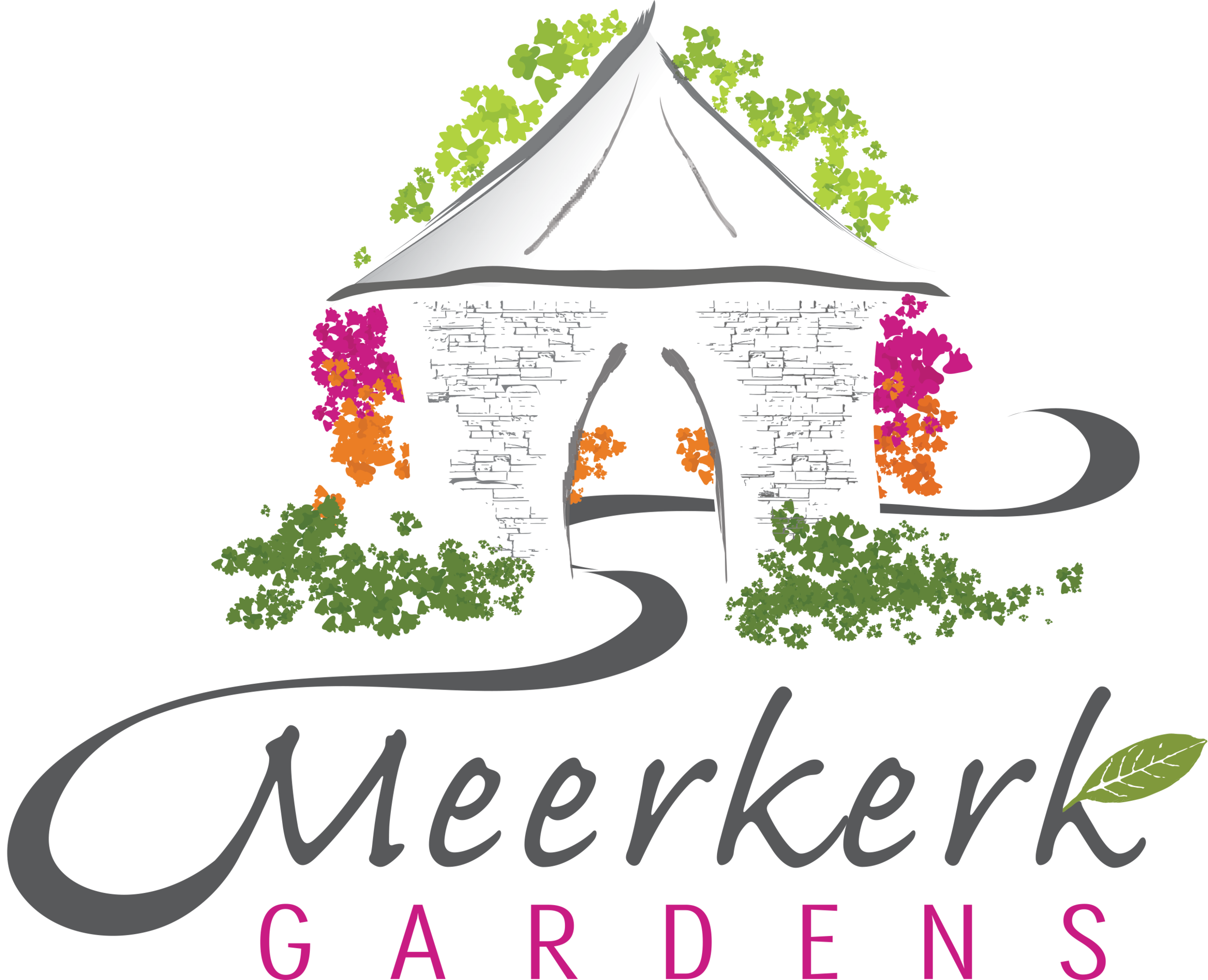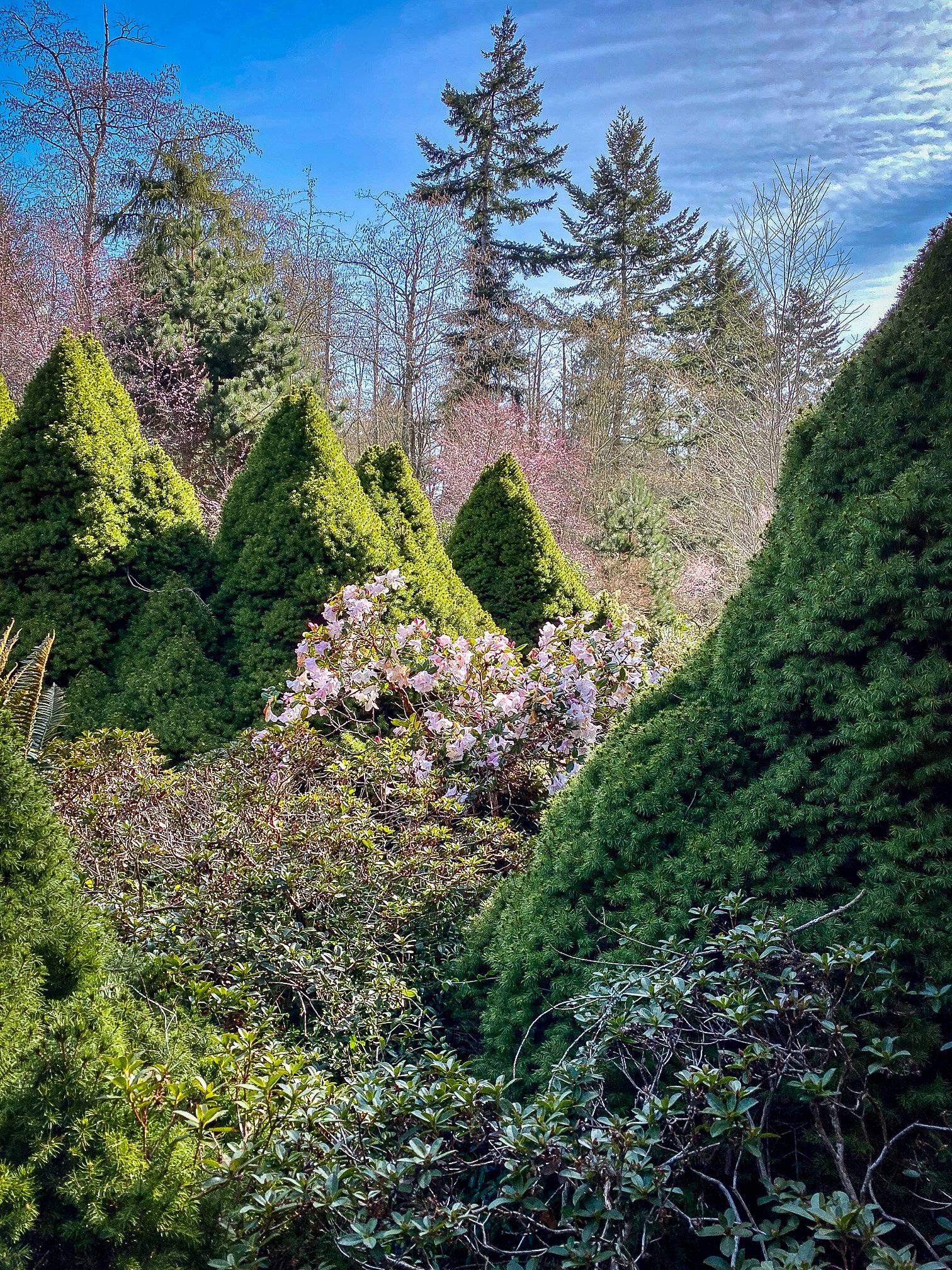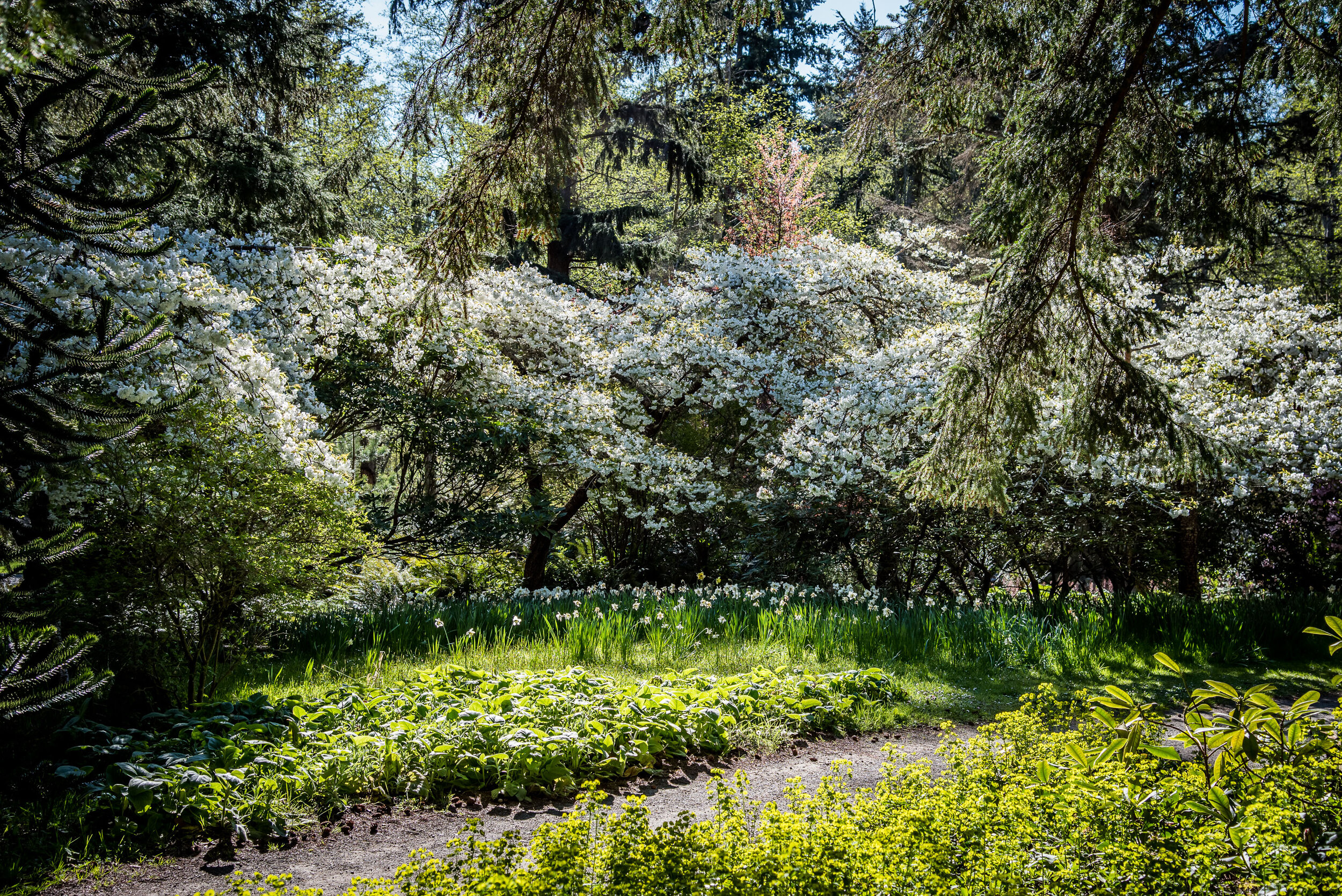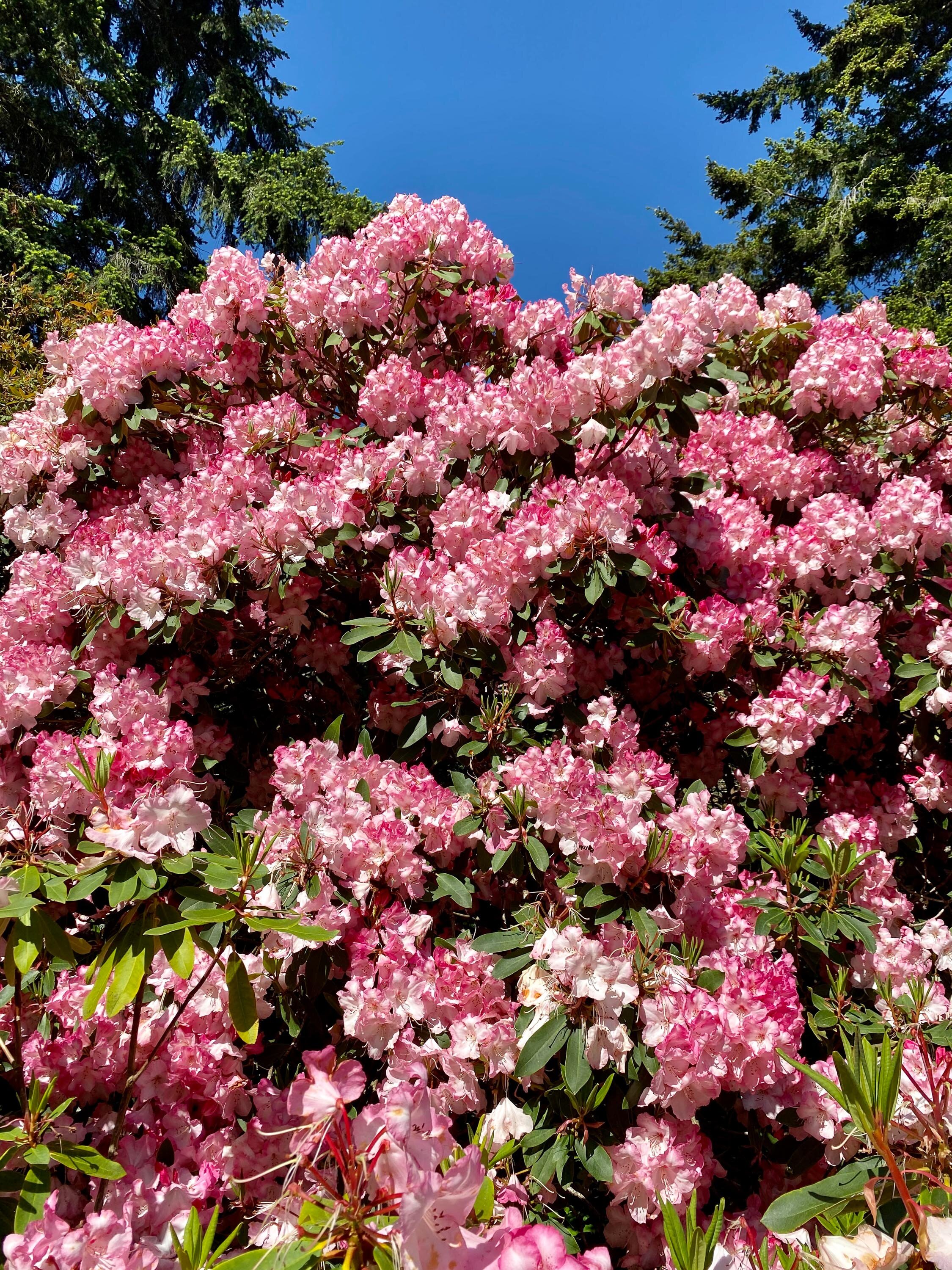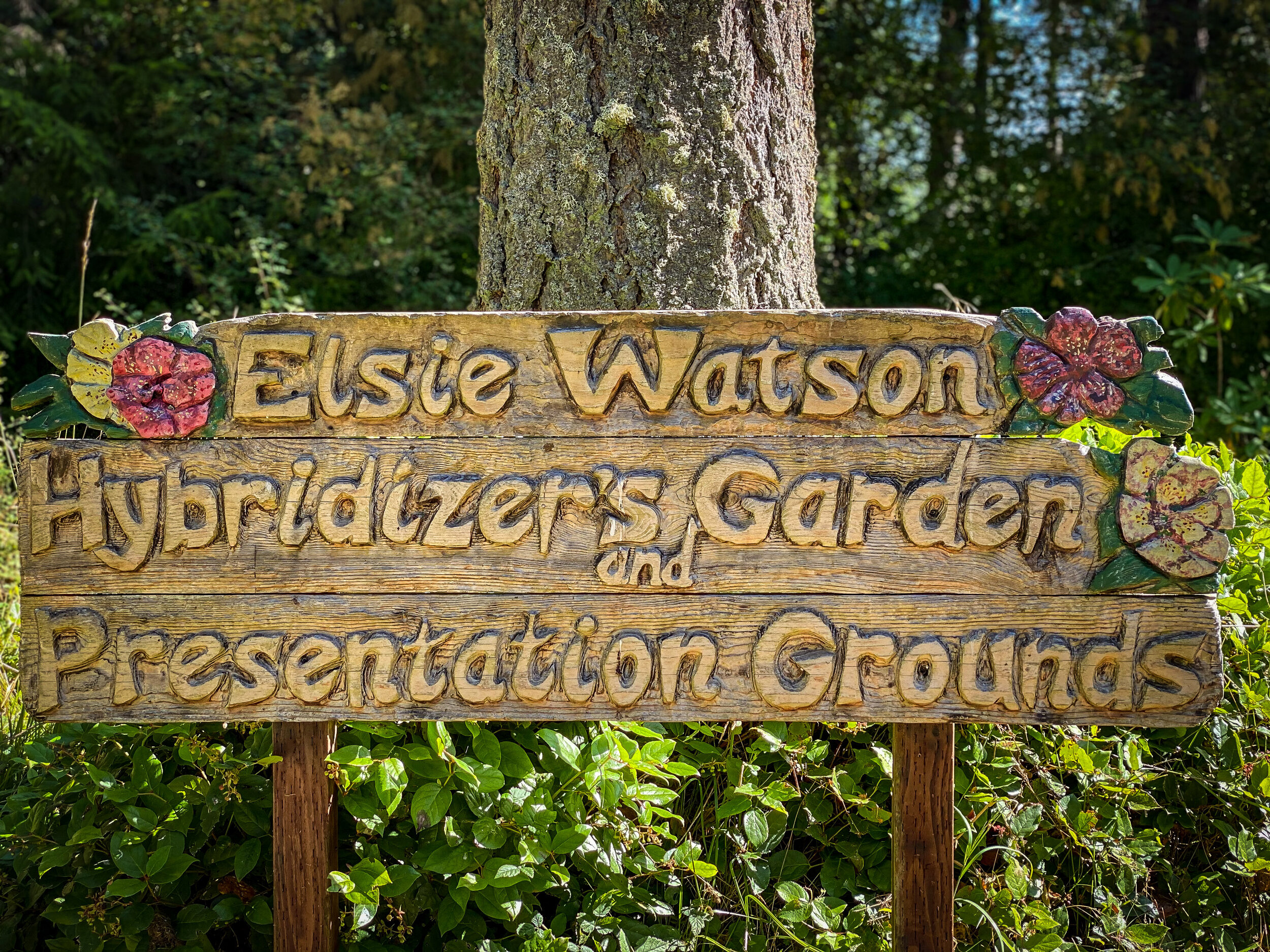Features of the Garden
Features of Meerkerk Gardens
The 10-acre centerpiece of the Meerkerk Gardens is comprised of many garden rooms, which the Meerkerks began creating in the early 1960s. Inspired by the Rothchild’s Exbury Garden in England, the Meerkerks wished to create a fine collection of rhododendrons and companions plants in a Pacific Northwest setting. The 10 acres of mature display gardens are surrounded by 43 acres of second growth forest, providing space for people to enjoy nature through gardening, hiking, cultural events, and hands-on learning programs.
Entry Gatehouse
This is the welcome station for a visitor where maps, brochures, and umbrellas for drippy days can be found! This lovely stone structure was modeled after the garden “Folly” in the Prince of Wales’ Gardens at Highgrove House near Tetbury in Gloucestershire, England. It was dedicated in May 2007 and is constructed of limestone and yellow Port Orford cedar from Alaska. The architect was Richard Rhydes. Stonework was done by Jim Stansbury and Barton Cole and Tom Fisher did the carpentry work. Katsura trees grace the sides of the Gatehouse and a Persian Ironwood stands to the right. After exiting the Gatehouse, don’t miss the Bloodgood Japanese Maple on the right as you enter the Gatehouse. The Loderi King George Rhododendron shades a nearby bench and provides large pink blossoms and delightful fragrance when blooming (Peak Bloom Season April-May).
Front Lawn Area
This lawn is the first area you come to as you leave the Gatehouse. It was an Island County Master Gardener project in 1990, and represents a healthy organic lawn. The gardens surrounding the front lawn highlight the early spring gardens with thousands of narcissus.
Hall Garden
This was the first garden donated to Meerkerk by Harold and Rosalee Hall and contains a collection of mature yakushiamanmum rhododendrons from Japan, commonly known as “Yaks”. The garden also contains a “nurse” log that provides nutrients to new plants as they grow.
Ramsey Rock Garden
The Ramsey Rock Garden is located below the Gatehouse and Hall Garden. Named for its creator Jim Ramsey, you will find lovely companion alpine spruce conifers along with a host of small leafed rhododendrons. It was conceived as a garden to exhibit dwarf rhododendrons and companion plants. The design uses Dwarf Alberta Spruce to represent a mountain hillside, with inspiration from Mount Baker’s heather meadows. The smaller leaf rhododendrons by hybridizer Warren Berg are planted at the bottom of the garden for their sun tolerance. Berg named many of his Rhodies with word “bee”. Look for Wanna bee, Queen Bee, To Bee, Patti Bee, and others.
Cherry Tree Alley
In late March and early April, as you leave the entry garden, Cherry Tree Alley greets you. This garden was installed in 1995 by then Director Kristi O’Donnell with assistance from Keith Bowers and volunteers. Mount Fuji cherry trees are under planted with thousands of white daffodils, which represent the late winter snow melting, forming a white stream of bloom.
Monkey Puzzle Tree
This specimen was collected by Ann Meerkerk at the 1962 Seattle World’s Fair. It blossomed for the first time in 2007. It now produces large cones that breakup before they leave the tree. This tree grows naturally in Southern Chile and Southwest Argentina and grows well in temperate zones such as Europe, North America, and Northern Asia. It can be found in many gardens and parks. What makes it distinctive is the foliage, which is arranged in whorls of leathery, sharp, scaly leaves that spiral around its twigs, thought by some to have evolved as a defense against dinosaurs and other big South American herbivores, most of them long extinct. This tree is considered to be the most ancient conifer present on the planet. Their form is identical to fossilized Monkey Puzzle trees dating back 160 million years. Restored maps of Chile show that in 1550, Monkey Puzzle forests dominated the country. The fruits that grow within the cones are Pine nuts (piñones) and are an important source of carbohydrates for the 60,000 Mapuche people who live in the southern Andes. This tree was introduced to Europe from seed brought by Archibald Menzies, who pocketed the "nuts" served at dinner by the governor of Chile. It was commonly planted in estate gardens in the late 1800's where an observer remarked, "It would puzzle a monkey to climb that tree, by George!"
Lem’s Patch
Named after famous PNW hybridizer Halfdan Lem, this area showcases rhododendrons obtained from his Everett nursery by the Meerkerks. Lem was a Norwegian fisherman and it is said he started his first plants on his fishing boat! Make sure to find the ‘Original Walloper’, the first Walloper hybridized by Lem. Recently, the landscape has grown to complement the fragrant azaleas nearby, creating an aromatic pathway.
Big Leaf Valley
The Big Leaf Valley is west of the Gatehouse before the entrance to the Nature trail. Creator Carl “Jake” Jacobson along with assistance from Don Kohlenberger and Dennis Gibberson, began the development of the Big Leaf Valley in 1999. The purpose was to create an environment for large leaf arboreal type rhododendrons along the sides of the valley above the upper pond. The dappled light from the forest provides shade for the species rhodies. Underground springs drain down this valley, filling the ponds with irrigation water and creating a moist, humid atmosphere in the Big Leaf Valley. The soil is rich with humus. An understory of lower-growing species was planted in 2000. This garden is still maturing. While some of the species will bloom before they mature, it will take decades for the canopy to fill out. Species featured include Rhododendrons hodsonii, essangea, rex, rithchildii, falconers, sino-falconeri, and sinogrande, just to name a few. Many were brought here from such faraway places as the Himalayan Mountains. Plants in this area came from the original Meerkerk collection from Warren Berg, The Rhododendron /species Botanical Garden, Garratt Richardson, June Sinclair, Frank Fujioka, Bernie Swenson, Paul Christensen and Jake Jacobsen.
The Meditation Garden
As a gift to his wife Dorothy, Jim Hussey funded the design and installation of the Meditation Garden to honor her work as a renowned landscape architect. Dedicated in 1995, before her passing, this Meditation Garden provides a bridge from the Gardens to the forest. The bridge was handcrafted by Whidbey artisan Kim Hoetling from Alaskan yellow cedar.
The Ponds (LOWER, MIDDLE, UPPER)
Meerkerk's three ponds are essential for irrigation to the gardens. Max Meerkerk dug two ponds with the help of Charlie Christie. The upper pond was put in under the leadership of Bill Stipe. The middle pond was developed by landscape architect Jim Hussey and his wife Dorothy. See a dogwood and a Dove tree on the eastern slope.
Secret Garden
This 5-acre area is the original Garden developed by Ann and Max Meerkerk in the early 1960s. Hidden in the middle of the woods, it acquired the name “secret garden.” Many of the unique trees planted here can also be found at the Seattle Washington Arboretum. The rhodies in this area are mature and form a wonderful canopy to explore. Look for the diamond bark maple, the paper bark maple, in addition to several large rhodies. The artistic background of Ann — weaver, painter, and potter — no doubt influenced the color schemes and textures in the landscape. Max loved plants with indumentum (covering of hairs found on the underside of the leaves of many rhododendrons), Magnolia sargentiana robusta, and Prunus wiltonii, along with flowering cherries, fragrant viburnums, and towering azaleas that offer a long seasonal bloom period. The epicenter of this garden they called “First Love” is hidden in a grove of verdant sword fern. The ferns and spring blooming False Lily of the Valley and Salal create a carpet beneath the magnolias and mature rhododendron trees.
Asian species Hillside Garden
This section of Meerkerk Gardens showcases species native to Asia. Most of the rhododendrons were collected in the wild by Warren Berg, Garrett Richardson, and Steve Hootman. This expands the original sections of the Garden from the Meerkerk era, which includes species and many of Ann’s first hybrids. Specimens include phachysanthum, wassonii, falconers praetans, wardii, lanatum, macabeanum, striglosum, arboretum, callophytum, and many more Asian species.
Rain Garden
The Rain Garden (a bio swale) is located on Meerkerk Lane along the access road approaching the Presentation Grounds and Nursery. It runs along Meerkerk Lane through the Secret Garden. The over 600 foot system was designed and built from 2009-2012 by Barton Cole, Special Projects Gardener, and the Whidbey Island County Conservation District. It’s considered one of the longest rain gardens on the West Coast! This hand dug feature appears as though it’s a natural feature of the garden, with plantings of ferns and other plants that like to have their “feet” wet along the banks. Former Garden Manager, Kristi O’Donnell contributed to the design and plant placement. This bio swale was installed to help mitigate severe flooding of the road, the Nursery, the gazebo, and presentation grounds and we are so happy it works!
Built in phases over four years to convey the storm water through a series of swales and pools, this bio swale enters two, four inch pipes that convey the water to a pond. The pipe system was installed as emergency repair and was not adequate to handle the flow resulting from the heaviest storms. Phase 2 included replacing almost 300 feet of the pipe system with another series of open swales and pools as well as a section of 10” pipe where the flow passes under the access road. WICD performed the field elevation work and provided design guidance and detailed design drawings. Designed to act more like a natural drainage system, the open swales and small ponds serve to remove sediment from the storm water flows via filtration through the soil and deposition in the pools. The total volume of storm water is reduced due to uptake by plants and absorption into the soil. This serves to nourish the soil and plants at the gardens, but also recharges the groundwater aquifer that supplies drinking water for the area’s residents.
Nature Trails
Of the 53 acres that make up Meerkerk Gardens, a large portion has been designed as “wilderness” with no plans for development. In this area located west of the Big Leaf Valley are the Woodland and Garden View with 4.5 miles of nature trails that take you through bog areas with native wetland inhabitants. Look for stately stands of Douglas fir, Grand fir, hemlock, cedar, and red alder. You may even spot a bald eagle, a pileated woodpecker or our Whidbey Island deer on the woodland trails. The Marine trail offers views of the Saratoga Passage with Mount Baker and the North Cascades as a backdrop.
Elsie Watson Hybridizer Garden and Gazebo
The Gazebo was built by Don Lee, Bob Boehm, and Steve Stanberry from trees that fell in a windstorm in the late 1990s. The Gazebo hosts our events, concerts, and occasional weddings. The presentation area with picnic tables and benches is a wide open, flat, grassy area suitable for large groups. This is a great spot to enjoy the unobstructed views of Holmes Harbor and Camano and Baby islands with the Cascade Mountains as a backdrop. This beautiful view is due to the efforts of Don Lee who is credited with getting West Coast Tree Care, Inc. to donate cutting and trimming of over 40 trees. The Garden behind the Gazebo features plants from local hybridizers Frank Fujioka, Jim Barlup, Bill Stipe, and of course, Ellie Watson who also funded the garden.
meerkerk Gardens’ Benches
The Gardens’ benches allow you to rest in the various areas. We believe that the essence of a peaceful woodland garden is a good place to sit and ponder, read, observe nature, and rest your feet – to use a popular term, “Forest Bathing.” Our Gardens feature nearly 50 unique benches to choose from! These were mostly constructed by Bill Tucker. Many were funded by donations and have plaques with dedications to those who have supported the Garden.
Garden Art
There are various art pieces scattered around the Garden that were donated by local artists. Look for the Bald Eagle statue on top of the cut tree that watches over the Hybridizing Garden. The hand carved signs that are posted on the highway, the entrance, and at the Gazebo were artfully designed by Pat McVay.
Meerkerk Buildings
The Meerkerk’s Main House was built in a northeastern section of the Gardens where it captures the water views of Holmes Harbor. It was built in the early 60s and reflects the mid-century style and décor popular from that era. It is now used for meetings, classroom events, and by staff. We hope to renovate it to better accommodate these purposes in the near future! At times during the Gardens’ history, it has been used as a home for the caretakers and managers of the Garden.
The Volunteer Cottage serves as an administrative office, kitchen and meeting place for volunteers and staff. Originally, it was used as a dog kennel for the Meerkerk’s large pack of over 50 dogs, mostly Weimaraners. Boarded up dog doors can still be seen on the outside of the cottage. Next to the cottage is the Jim Barlup Propagation House, which was donated by garden supporter and hybridizer, Jim Barlup. It is used by Meerkerk Gardens staff and volunteers for propagation of plants.
The Nursery
After Max Meerkerk died, Ann Meerkerk raised sheep to use the wool for one of her favorite pastimes – weaving. The original nursery building was one of those sheep sheds. As a result of many windstorms, the shed had deteriorated and needed to be rebuilt in 2019. Like the original sales shed, the new Nursery building is dedicated to Mel and Marilyn Wright, Gardens supporters and dedicated volunteers.
Open on weekends from mid-March through June, and then again in the fall, our specialty Nursery stocks rhododendrons, azaleas, companion plants, and native plants. Rhododendrons are offered in a variety of sizes and colors. We employ growing standards and sustainable practices to protect the health of the watershed. Proceeds from the Nursery provide approximately 20% of Meerkerk’s operating budget.
